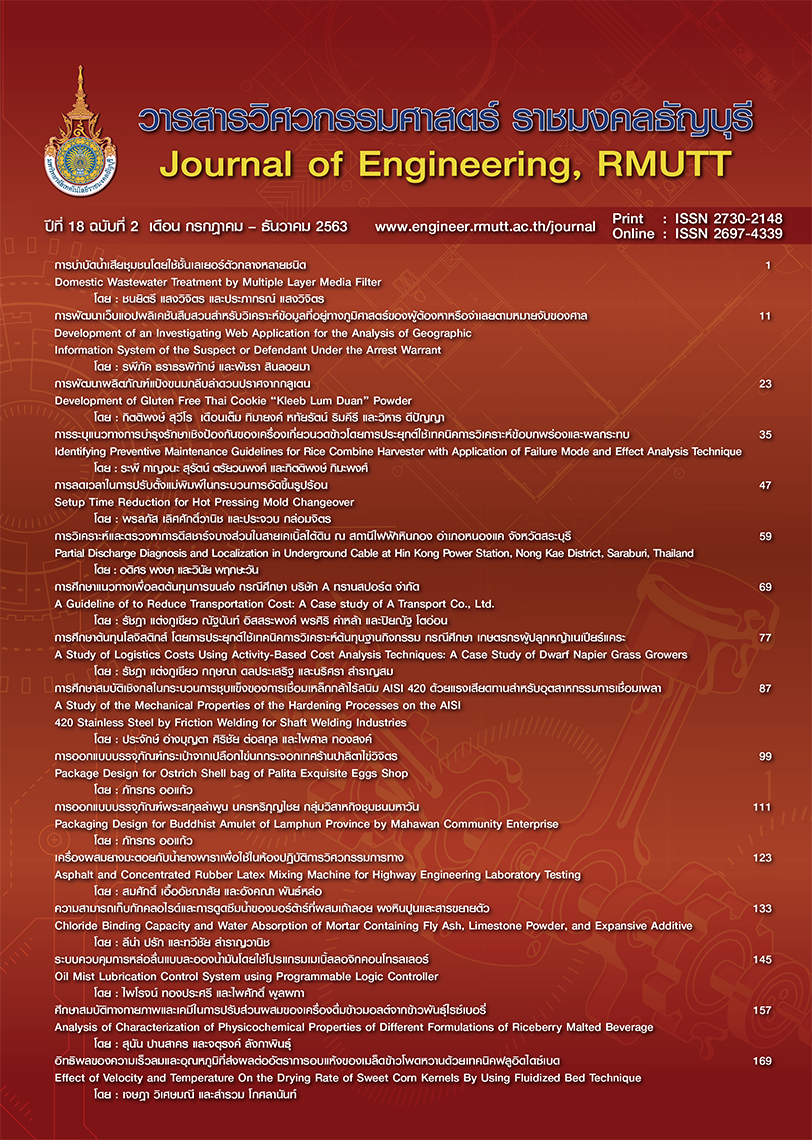Development of Gluten Free Thai Cookie “Kleeb Lum Duan” Powder
Main Article Content
Abstract
This research aims to develop the product of gluten free Thai cookie “Kleeb Lum Duan” powder by changing the wheat flour (main ingredient) to the rice flour, glutinous rice flour, and gluten substitutes including: guar gum, xanthan gum, and isolated soy protein. These replacing were the ingredients for forming the Thai cookie “Kleeb Lum Duan” structures instead of the gluten from wheat flour. Cooked the Thai Cookies “Kleeb Lum Duan” by mixing with the vegetable oil, sugar, and salt. Sculpted the mixed ingredients as melodorum fruticosum flowers and baked them in the oven (150 oC for 10 minutes). Then, the scented candles were used for smoking the cookies (15 minutes). The property tests of Thai cookies “Kleeb Lum Duan” included the color, hardness, water activity, and porous structure. The sensory, and consumer acceptance of Thai cookies “Kleeb Lum Duan” were tested in appearance, color, texture, taste, and overall acceptance properties. In the shelf life of Thai cookie “Kleeb Lum Duan” powder test, it used the predicting from the quality of Thai cookie “Kleeb Lum Duan” when the powder was contained in vacuum aluminum foil for 6 months (at room temperature). According to the results, the rice flour, glutinous rice flour, guar gum, and xanthan gum can use for cooking the Thai cookie “Kleeb Lum Duan” instead of wheat flour. These developed Thai cookie “Kleeb Lum Duan” has the color, hardness, and structure as same as the original Thai cookie “Kleeb Lum Duan” which used the wheat flour or gluten flour. The appearance, color, texture, taste, and overall acceptance properties were accepted by consumers that be similar to the original Thai cookie “Kleeb Lum Duan”. Moreover, the developed Thai cookie “Kleeb Lum Duan” powder can keep in the vacuum aluminum foil for 6 months while the quality does not change.
Article Details
The manuscript, information, content, picture and so forth which were published on Frontiers in engineering innovation research has been a copyright of this journal only. There is not allow anyone or any organize to duplicate all content or some document for unethical publication.
References
Office of the Royal Society. 2011 Dictionary:Office of the Royal Society version.Bangkok: Office of the Royal Society;2013. (in Thai)
Molina-Infante J, Santolaria S, Sanders DS, Fernández-Bañares F.Systematic review: noncoeliac gluten sensitivity.Alimentary Pharmacology & Therapeutics.2015; 41(9): 807-20.
Kang JY, Kang AH, Green A, Gwee KA, Ho KY. Systematic review: worldwide variation in the frequency of coeliac disease and changes over time.Alimentary Pharmacology & Therapeutics.2013; 38(3): 226-45.
Gomez FR, Pedro AC, Carlos AB, Cristina MR. Functionality of different hydrocolloids on the quality and shelf-life of yellow layer cakes. Food Hydrocolloids.2007; 21(2): 167–73.
Phillips GO, Williams PA. Handbook of Hydrocolloids. 2nd edition, Cambridge:Woodhead Publishing Limited; 2000.
Shri KS, Steven JM, Syed SHR. Food Process Engineering: Theory and Laboratory Experiment. New York: A John Wiley & Sons., Publication; 2000.
Timayoonk D, Rimkeeree H. Implementation of traditional Thai snack wisdom for the production of semi-ready to cook Khanom Tan powder. Research on Culture. 2019; 2(2): 109-20. (in Thai)
Parnsakhorn S, Langkapin J. Effect of temperature on soaking and drying on quality of parboiled Hom-nin rice.Journal of Engineering, RMUTT. 2019;17(1): 175-85. (in Thai)
Wanyo P, Chomnawang C, Siriamornpun S.Substitution of wheat flour with rice flour and rice bran in flake products: effects on chemical, physical and antioxidant properties. World Applied Sciences Journal. 2009; 7(1): 49-56.
Sriroth K, Piyajomkhaw K. Starch Technology.3ed edition, Bangkok: Kasetsart University; 2007. (in Thai)
Piotr PL. Water as the determinant of food engineering properties: A review. Journal of Food Engineering. 2004; 61(4):483-95.


